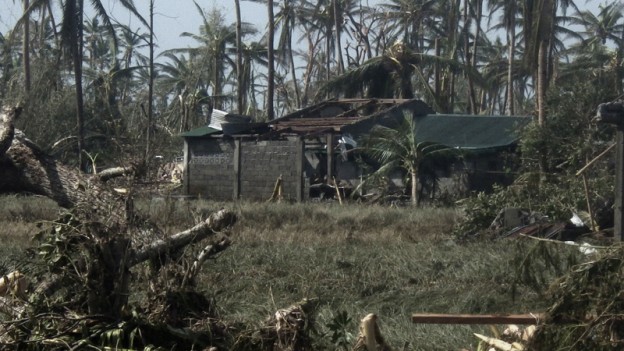Friday, November 8, 2013 – continued:
(Starting now and going over the next few days might seem a bit scattered, because I was pretty much in some state of shock during the whole experience starting when the flooding began. I’m still recording it to the best of my own recollection, but my thoughts concerning them are much less organized than before.)
Upon leaving the room in which we had sought refuge for most of the storm, we were able to see just how bad the storm was. Passing through what would have been the living room, which still had about 6 inches of water on the floor; we saw that half of our entire roof was completely gone, and that the ceiling and the entire framework holding it together in that half of the apartment had collapsed. The shelves and cupboards that used to be on the wall were now on the floor. The refrigerator was on its back and buried in rubble. The large table in that room that had all of our proselyting supplies on it had been moved across the room. One of the doors had two of its three hinges broken and could no longer be closed.
We then entered our bedroom to see how all of our belongings had fared. The floor of the bedroom was raised a few inches higher than in the other rooms, so the water was not as deep there anymore. Our room literally looked like it had been hit by a typhoon, probably because it had actually been hit by a typhoon. The roof was still intact over the bedroom, but the four-foot flood had done a lot of damage.
There was still three inches of water in the room at the time. A layer of dirt had settled on everything that had been submerged. Dozens of ruined books were strewn on the floor. All of them had become distended with water. Hundreds of papers from packets, reams, and folders had been scattered all over the floor beneath the settled dirt. It seemed that everything must have been destroyed.
Before the storm, we had placed things that we had wanted to preserve inside our bags that we had placed on the top bunk. Some of the other important items, however, had been with us inside the fort on the lower bunk, which was below the highest water level during the storm. Fortunately, however, it turned out that the double layer of polyurethane foam mattresses that had been on the lower bunk were buoyant enough that when the flood waters had reached them, they had floated on top, despite the weight of some of the bags that had been placed on them.
The bags on the top bunk had gotten wet from the spray of the wind and the water that had been dripping from the ceiling throughout the apartment that still had a ceiling at the time. Because we had placed the mattress on top of our bags, though, nothing inside was destroyed by the water.
So all in all, everything that we had taken specific measures to preserve was preserved. Everything that had been left was destroyed. This was the first point of four over the next five days in which I would lose almost everything that I had. After this first point of loss, I had a small duffle bag full of important things, and two large rolling duffels half full of some my clothes and other less important supplies. Over the next five days, I would have my possessions narrowed down to only about 8kg in a small backpack.
After we had first left the small room in which we had weathered the storm, we also looked out the window. Normally, looking out through the decorative cement blocks (that could be seen in the video from the previous post) one would see a small yard closed in by a cement block wall with a banana tree, a coconut tree, and a few other plants. Normally, one would have seen a large, drained, and weed-filled rice field beyond the wall. On this occasion, however, all we saw was water. The wall was gone, the trees were gone, and if it hadn’t been for the hills in the distance, I might have supposed that our apartment had been blown away in the middle of the storm and had landed in the middle of the ocean. The waves were still coming in through the door to the kitchen, and beyond that door was only the rubble of what used to be a small covered area where the hand pump was.
Later on, when the water had drained somewhat, but the wind was still blowing hard, we saw groups of people trudging through the water in the most shallow parts that had previously been pathways. They were people who had fled their homes when the water had started to rise and had run to the hills, where they would have found themselves out of the water, but subjected to the brunt of the storm. These people were now returning to what was left of their homes.


